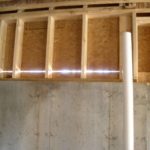As seasons change you may notice a new and unwanted cool breeze traveling through your home; or maybe you notice that cool breeze hitting your right in the pocket book. Either way, no homeowner wants to see their warm air and finances blow right out the door.
The 5 Major Areas Of Heat Loss In A Home

1.The Walls
The walls of a home that isn't well insulated can act like a sponge for heat. Drafts behind the drywall can pull warm air right through the sockets and small openings and out towards the cold exterior. Like a lot of the problems on this list, this heat loss can be mitigated by the right insulation and thermal wrap.
2. The Roof
When thinking of heat loss, most people wouldn't consider the roof to be the 2nd largest heat sink. Logically it makes since, heat rises so the roof is most often in contact with the most warm air. Much like the walls of a home, the heat loss from the roof can also be minimized with proper insulation. With the roof however there are a few other areas that may be causing your home to lose heat: uncapped chimneys can act as a vacuum pulling warm air directly out of your homes interior. It's best to have a roof inspection before winter anyways to ensure your roof is ready for the weight of snow, so while your contractor is performing his inspection be sure to ask him to check the chimneys as well.
3.Windows
Everyone knows this one, just walking past a single pane window can expose a major temperature difference. This one is an easy fix, upgrade your windows to efficient double or triple paned windows. I know this may seem like an expensive fix but believe it or not, replacing old windows can save you serious cash over the life of a home :How New Windows Can Save you Money.
4. Ventilation
Make sure there is good air flow and no blockage to air movement in your home. Improper ventilation can lead to wide ranges in temperature throughout the home.
5. Floor
Thats right, the floor. Although it isn't as dramatic as the walls of the home the floor is still one of the largest surface areas and thus has some of the greatest potential for heat loss. Luckily heat rises so that helps to negate the problem but make sure your floor has the proper underlayment and insulation to ensure you aren't letting your heat slip through the cracks.
Well thats it, now that you know the major areas your home is losing heat you can stay warm this winter. If you want a few more tips and tricks to protect your home from the weather give us a call or check out some of our later blog post!


